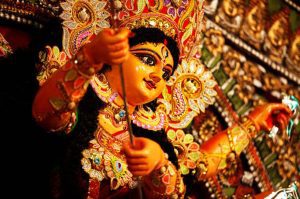
Kolkata Police Warn Pandal Organisers: With Durga Puja around the corner, Kolkata Police has sent out a stern reminder to club and pandal organisers across the city: do not obstruct CCTV cameras and do not block the flow of traffic. The warning, issued during a high-level meeting at Lalbazar, comes as the city prepares to welcome lakhs of pandal-hoppers and devotees, making crowd and traffic management a herculean task.
Durga Puja is more than just a religious festival—it’s Kolkata’s identity, heritage, and cultural pride. But it is also a logistical challenge. With thousands of pandals mushrooming across the city, streets often get clogged with barricades, decorative arches, lighting setups, and sponsor hoardings. When these installations block surveillance cameras, it weakens police visibility. When they obstruct roads, it slows down emergency response vehicles and creates traffic snarls.
This year, police want to avoid both.
The CCTV Factor: Safety Beyond Surveillance
Kolkata has one of the densest CCTV networks in eastern India, with cameras installed at major crossings, metro gates, and high-traffic areas. During Durga Puja, these cameras act as the city’s “digital eyes,” helping officers track traffic flow, manage crowd surges, and respond to emergencies in real time.


When cameras are blocked by pandal gates or decorative arches, entire junctions become blind spots. This creates vulnerabilities—both in terms of crime prevention and in crowd control. “We have invested heavily in surveillance infrastructure; blocking a camera for decoration can compromise safety for thousands,” a senior officer reportedly told organisers.
👉 Related context:
Government of India’s Smart City Mission on use of CCTVs for urban safety
Traffic Woes: A Recurring Challenge
Every year, Kolkata faces gridlocks during Puja nights when pandal-hoppers throng the streets. While traffic diversions are planned weeks in advance, last-minute hurdles often come from unapproved barricades or sponsor stalls erected outside pandals.
Police have clearly instructed clubs not to build gates that choke roads or narrow lanes further. In congested areas like North Kolkata, even a few feet of encroachment can cause hours-long bottlenecks. In South Kolkata, areas like Gariahat, Rashbehari, and Ballygunge witness similar chaos.
According to officials, traffic guards from all 26 divisions will be conducting on-ground checks from September to ensure no cameras are blocked and no roads are unlawfully barricaded.
👉 Further reading:
Ministry of Road Transport and Highways – Traffic Management in Indian Cities
Kolkata Police Warn Pandal Organisers: Balancing Creativity and Compliance
Durga Puja pandals are globally known for their artistry. Many clubs compete to outshine each other with unique themes—replicas of monuments, eco-friendly concepts, or artistic social messages. However, in the race for grandeur, compliance often takes a backseat.
Police officials reminded organisers that creativity should not come at the cost of safety. “We respect the artistic freedom of puja committees, but public convenience cannot be compromised. If a pandal structure blocks visibility or hinders traffic, it will be removed,” an officer cautioned.
This balance—between artistry and accountability—is expected to dominate discussions in the weeks leading to Puja.
Crowd Control: Lessons From the Past
Kolkata has witnessed several incidents during previous Pujas where lack of proper planning created panic. Instances of stampedes in overcrowded lanes, ambulances stuck for hours, and cases of theft in dark or unsupervised corners have highlighted the risks.
The police now insist on:
- Unblocked CCTV coverage around pandals.
- Clear entry and exit lanes for visitors.
- Emergency vehicle corridors that must remain free.
- Controlled use of sponsor banners and stalls.
👉 Case study reference:
NDMA Guidelines on Crowd Management in Indian Festivals
Technology as a Festival Partner
Beyond surveillance, police are also using technology to manage crowds this year. Drone monitoring, mobile apps for traffic updates, and social media alerts are expected to be deployed more extensively. Citizens will receive live updates about road closures, diversion plans, and crowd hotspots.
This technological integration is meant to ensure that while Kolkata celebrates its biggest festival, the city’s pulse remains under control.
A Shared Responsibility
While much of the responsibility lies with the police and civic authorities, the participation of puja committees and citizens is equally important. Club organisers are being reminded to work in collaboration with traffic guards rather than treating compliance as a burden.
Civic activists also argue that citizens should act responsibly—avoiding littering near pandals, following traffic diversions, and reporting safety violations.
Durga Puja, they point out, is not only a celebration of faith and art but also a test of collective civic discipline.
Looking Ahead: A Model for Other Cities?
The move by Kolkata Police could become a model for other Indian metros like Delhi, Mumbai, and Bengaluru, where festivals regularly cause traffic disruptions and surveillance gaps. Pre-emptive coordination with organisers, instead of post-incident crackdowns, represents a proactive model of crowd management.
If successfully implemented, Kolkata’s 2025 Durga Puja could set new benchmarks in balancing celebration with civic responsibility.
External References
- Smart City Mission – CCTV and Safety Measures
- NDMA – Guidelines on Crowd & Festival Safety
- Ministry of Road Transport & Highways – Traffic Management
- Kolkata Police Official Website – Traffic Notices & Alerts
Also read: Home | Channel 6 Network – Latest News, Breaking Updates: Politics, Business, Tech & More

